![]()
Hunting for Flädle at Ries Crater
We travel to Nördlingen Germany to find these impact-glass "bombs".
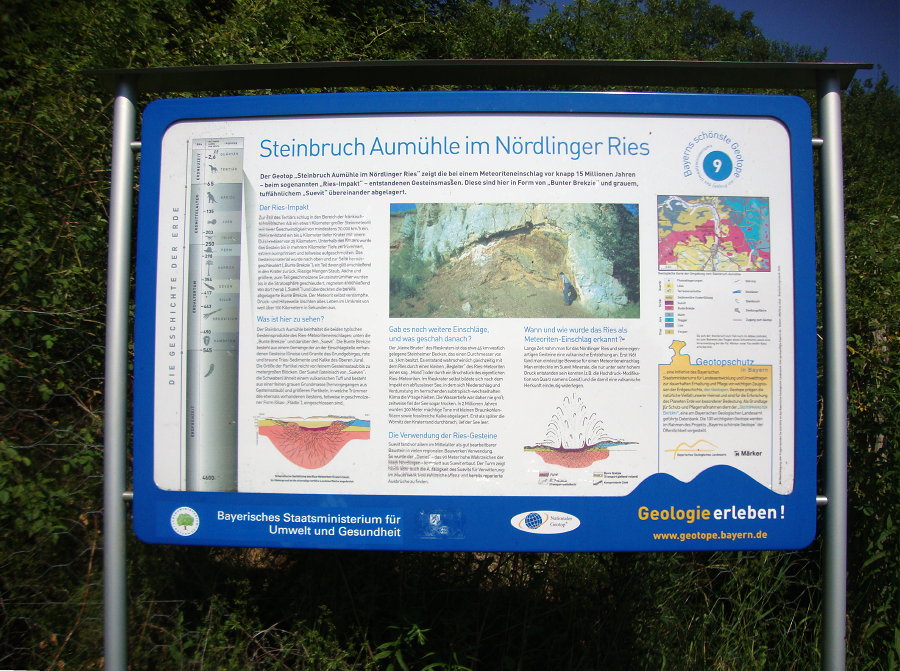
June 2011 - this was the year that I finally made that return trip to Germany. It was a good time of year to revisit Southern Germany where I lived 40 years ago and met for the first time my soul-mate, and now finally my fiance, Monika Waiblinger. We traveled together from San Diego.
Our first destination was her hometown where I got to meet her relatives. Those relatives, knowing her keen interest in meteorites, were very understanding when we shortly departed for a day-trip to the Steinheim Crater. Moni and I would have loved to stay longer at Steinheim but we had to return for a quick turn-around trip to the Ensisheim 2011 Meteorite Show. I have already written about our trip to Ensisheim in my July 2011 article), but in the near-future I really must report on our day-trip to the Steinheim Crater, because that was a very enjoyable locality to visit.
It was at the Ensisheim Show that we confirmed our decision to make a trip to the Ries impact-crater at Nördlingen (also known as, Nördlinger- Reis). It was at the Ensisheim Show that I saw, and understood for the first time, what was a flaedle, or as it is called in German, "Flädle". I now understood a flädle to be somewhat akin to a volcanic bomb, but instead of basalt, it is an [impact]-glass bomb of crater ejecta that has traveled through the air, but at a somewhat shorter distance than a tektite. Apparently it is not akin to a splash-form tektite, nor are they like Muong Nong tektites, but the reason why is not clear to me.
Since this article is but part of an on-line publication known as, Meteorite-Times Magazine, it is expected that most readers are knowledgeable about these kind of rocks known as, "impactites". But, for those of you who may have arrived here by way of an errant Google search engine result for "German pancakes", and are now curious about "impact-glass-bomb rock-collecting") you would be best served to go first to my "REFERENCES" section at the end of this article. There I have links to websites that describe what "flädle" are, and links to images of "flädle" which show that these impact-melted rocks look like bread dough that has been thrown into the air and then solidified.
Moni had already visited Nördlingen. Five years earlier on a previous trip to Germany, she somehow cajoled her sister to take her to both Ensisheim and Nördlingen! So, after the Ensisheim Show, when we returned to her relatives in Germany and told them of our plans to make another day-trip to, yet, another crater, they weren't in the least bit surprised. Again, her relatives were ever more understanding of the mutual interest in meteorites that Moni and I shared.
So, early one nice, Spring morning in June 2011, Moni and I drive off and head for the "Aumühle Quarry in the Nördlinger Ries Crater".
The following images are a travel log of our trip.
By the way, regarding the sign in the above image, a Geotope is not unlike a road-side-stop with a "point of interest" but which has some geological significance.
Translation
for the above sign titled, "Der Geotop "Steinbruch Aumühle in Nördlinger Ries" =
(This is a very rough ENGLISH translation.)
Title of the sign:
Quarry Aumühle in the Nördlinger Ries [crater]
The "Quarry Aumühle in the Nördlinger Ries" Geotope shows the rock
mass caused by a meteorite impact about 15 million years ago -
in the so-called "Ries Impact". These are deposited in the form of
"colored-breccia" and grey, tuff-like "suevite" over each other
here.
Description:
The Ries impact
At the time of the Tertiary period, an approximately 1 km large
stone meteorite with a speed of at least 70,000 km/h impacted in
the area of the Franconian-Swabian Alb. It formed an up to 4 km
deep crater with a diameter of 25 km.
Beneath the crater the rocks were smashed at several kilometers
depth, extremely compressed and partially melted. The rock material
was catapulted to the top and to the side ("Bunte Breccia");
part of it then glided back into the crater.
Huge amounts of dust, ash, and larger, partially molten rock debris
were thrown up into the stratosphere, then rained-down from there
("suevite") and covered-up the already deposited Bunte Breccia.
The meteorite itself evaporated.
Pressure and heat wave vaporized all life within a radius of
over 100 km in seconds.
What's to see here?
The quarry Aumuehle includes the two typical rock products of
Ries meteorite impact:
below the "Bunte Breccia" and above the "suevite".
The Bunte Breccia consists of a mixture of pre-existing rocks
(gneiss and granite from the bedrock, red and brown Triassic
sediments and limestone of Upper Jurassic). The particle size
ranges up to meter-sized blocks of fine stone dust.
The suevite (Latin from "Suevi", Swabian stone) is similar to a
volcanic tuff and consists of a fine grey groundmass (originating
from rock dust and larger particles), in which were included the
debris from the formerly existing rock [and most importantly
(for this article)
including the bomb-shaped globs] still in the partially molten form
(glass-bomb or 'Flädle').
Were there still other impacts, and what happened then?
The "little brother" of the Ries crater, the Steinheimer crater,
is located about 45 km west, and it has a diameter of 3 km. It
probably was formed at the same time with the Ries-impact, through
a small "Companion" of the Ries meteorite (a so-called "Moon")
or probably through a fragment of the actual Ries bolide.
After the impact, an endorheic lake formed in the Ries crater,
in which rainfall and evaporation in the prevailing subtropical,
changeable climate was kept in balance. The depth of water was
never large; at times, the lake was even dry.
Over the next 2 Million years, 300 meters of clay with small brown
hard nodules, as well as
fossil-rich limestones were deposited. Only later when the
Wörnitz River broke through the rim, then the lake ran empty.
When was the Ries recognized as meteorite impact?
For a long time, a volcanic formation was adopted for the
Nördlinger Ries and its peculiar rocks. But, in 1961, they found
clear evidence of a meteorite impact.
In the suevite they discovered minerals, which could have only been
formed under very high pressure (e.g., the high pressure
modification of quartz called Coesite),
and which thus clearly refute a volcanic origin.
[End of translation]
On a previous trip (a week earlier) to the Steinheim crater, we visited the local museum and studied the Flädle that were on display there from the Ries crater.
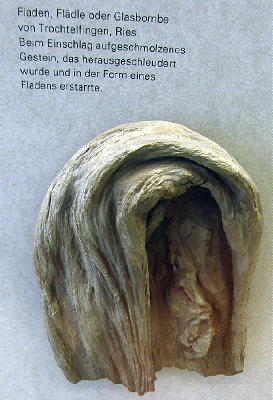
On an earlier trip we visited the museum at theSteinheim Basin where we saw this beautiful example of a "flädle". The German text in the above image:
"Fladen, Flädle oder Glasbombe von Trochtelfingen, Ries. Beim Einschlag aufgeschmolzenes Gestein, das herausgeschleudert wurde und in der Form eines Fladens erstarrte."Translates to :
"From the German word for 'flatbreads'. Flädle (pancake) or glass-bomb from Trochtelfingen, Ries area. Rock melted by an impact and that was ejected and froze into the form of a 'flatbread'."(You can click on the above image in order to ENLARGE.)
This wasn't Moni's first trip to the
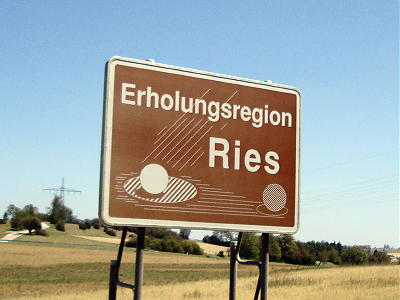
Translation : "Erholungsregion Ries" = Recreational region Ries
On the road to Nördlingen and the Ries Crater we encountered this sign which was our first hint that we were getting close to "ground zero" of an impact crater.
(You can click on the above image in order to ENLARGE.)
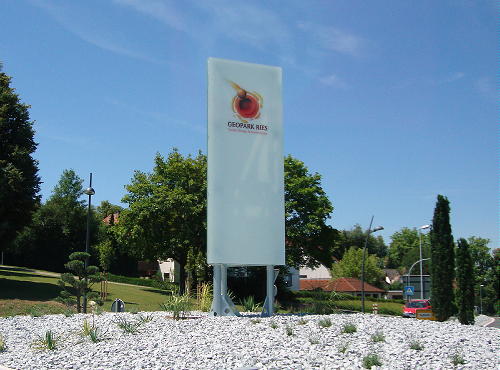
Upon entering the city limits of Nördlingen and the Nördlinger Ries we encounter another sign which gives us some indication of the significance of the impact crater to this city .
(You can click on the above image in order to ENLARGE.)
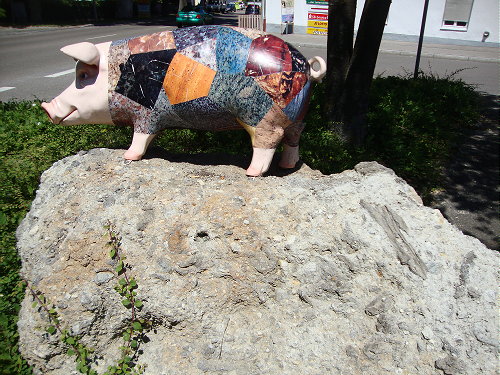
In the town of Nördlingen there are many decorative "schwien" statutes and this one sits upon a large boulder of local suevite, used as decoration in a traffic circle. Throughout the town, one can find suevite (rough and fabricated) being used in all sorts of manner. An example of a "flädle in suevite" can be seen in this image under the pig and to the upper right corner of the boulder.
(You can click on the above image in order to ENLARGE.)
On to the museum...
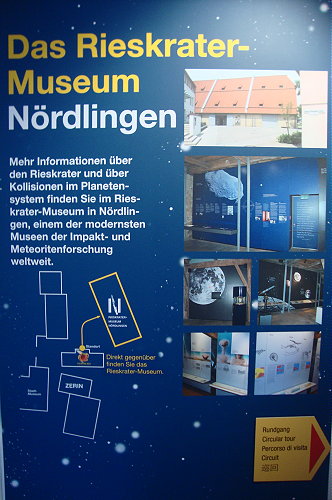
Now, while in the town of Nordlingen, we found the Ries Crater Museum where we were able to find good examples of "flädle" and suevite.
But first, we closely studied the geologic maps and photos of the outcrops.
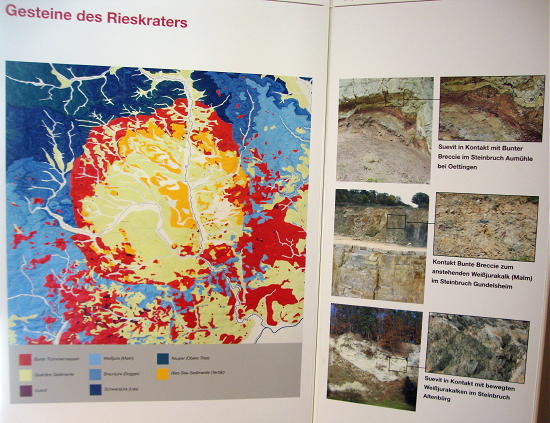
At the information center for the museum was this large poster board with a Geologic Map of the Ries [impact] Crater, as well as photos of outcrops with exposures of impactite throughout the crater - to include the Aumühle Quarry (our destination for this trip).
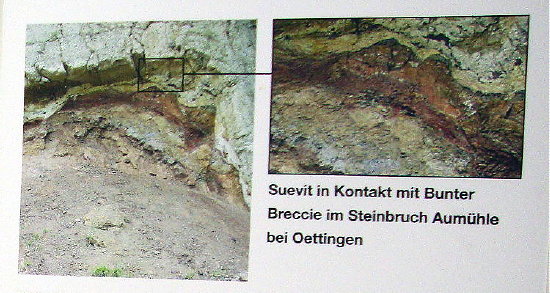
Here is a close-up of the above image of one of the photos & text on that "poster board" display. The photo is of that well-studied outcrop at the Aumühle Quarry. At the information center for the museum you can obtain an Information Booklet which contains all of the maps and photos that appear on the poster boards and other displays.
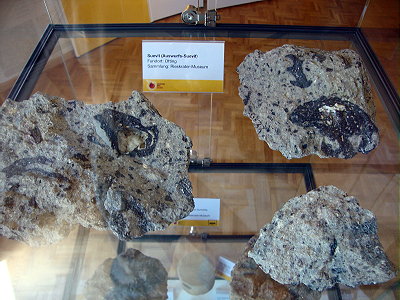
Now this is what we are looking for - suevite with excellent cross-sections of Flädle suevite with excellent cross-sections of Flädle. The label says "Ejection Suevite from Otting".
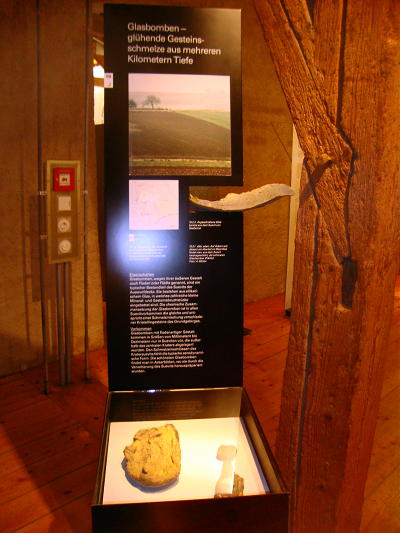
An excellent musem display about "Glass Bombs".
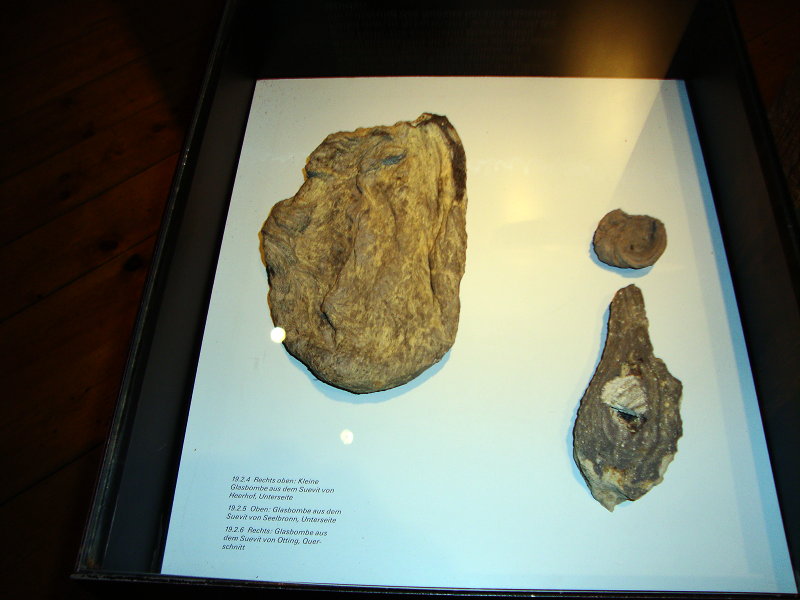
Close-up of a nice, large Flädle or as the label in German says, "Glass Bomb" - shows that impact (not volcanic) bomb was still molten/plastic when in settled back to Earth within the suevite formation.
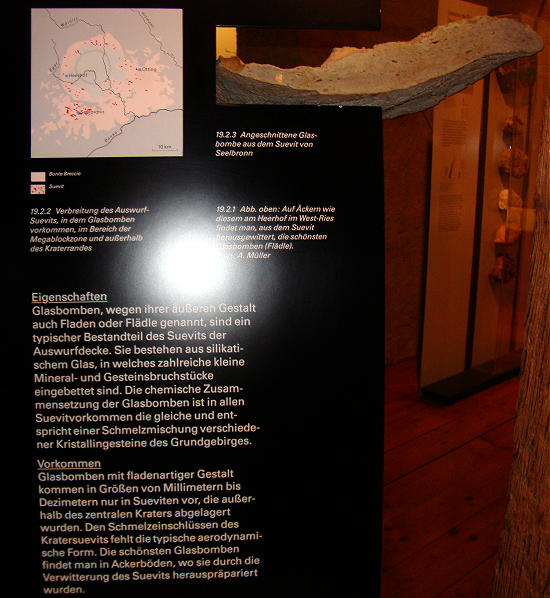
Here is a close-up of the German text on the Flädle display.
Very rough translation: "Within the suevite occurs these "glass bombs" which still maintain their basic dimensions, and can also be found as isolated finds. Due to its form, a person could tell that these Impact-glass globules were thrown into the air while still in a viscous state. They are referred to popularly as Flaedle (Flatbreads, pancakes)."
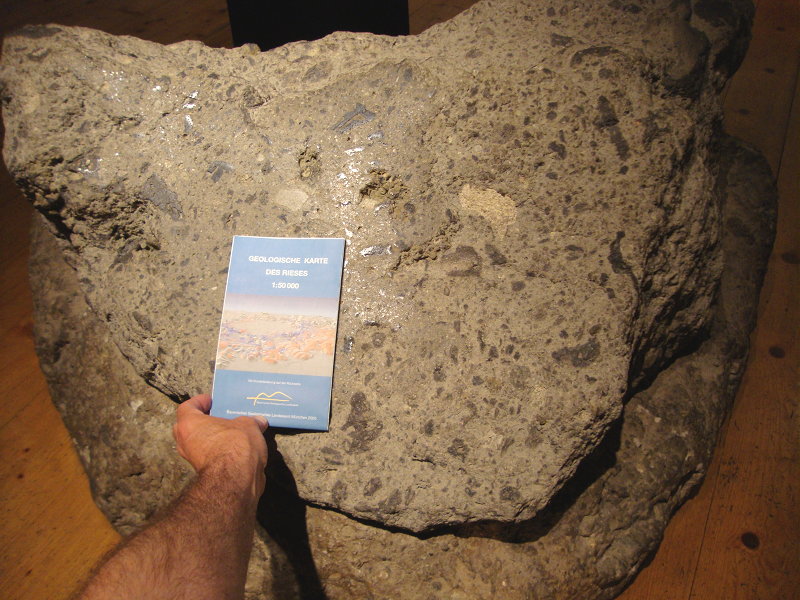
A huge boulder of suevite containing some small flädle. The map seen in this image is a good one and can be purchased at the entrance to the museum.
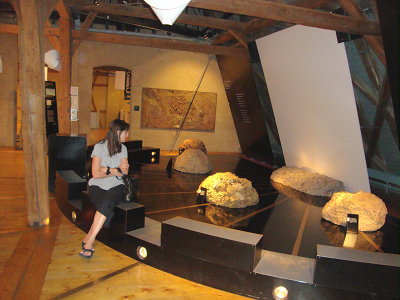
Monika Waiblinger sits at a display of boulders of suevite and other impact breccia. Kids can sit on the boulders and watch a video about how the Ries Crater was formed.
We had met Thomas Kurtz the week earlier at the Ensisheim 2011 Meteorite Show, and it was there that we made plans to meet him on this day after he gets off work at Wemding and he would show us the Steinbruch (Quarry) at Aumühle were there were excellent outcrops of the contact between the Bunte Breccia and the suevite, and exposures where fldle were weathering out of the suevite.
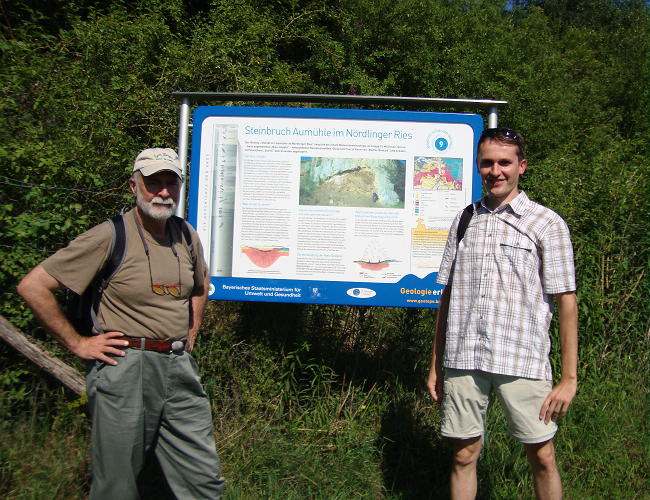
We met Thomas Kurtz at his office in
The sign at the entrance to the Aumühle Quarry states that this is "Geotop #9" - number 9 out of 100 geologically-interesting sites in Bavaria. (Go to the top of this article to see a close-up image of this sign and for a translation.)
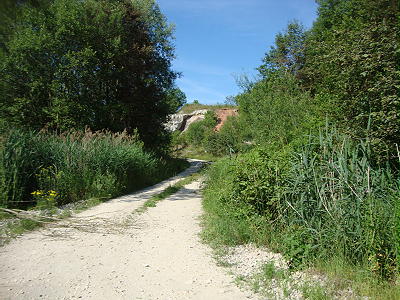
It is only a short walk to the first outcrop.
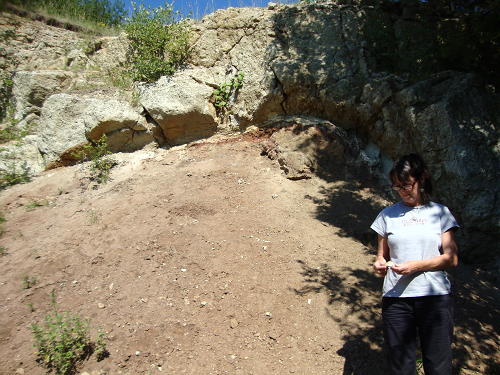
Monika Waiblinger examines a rock that came directly from the thermal contact zone where the Ries suevite deposited itself upon the Bunte Breccia (which is directly behind her).
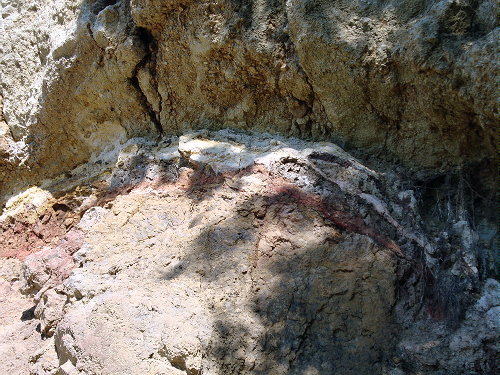
Compare this image with the same photo in this "Information Brochure".
(You can click on the above image in order to ENLARGE.)
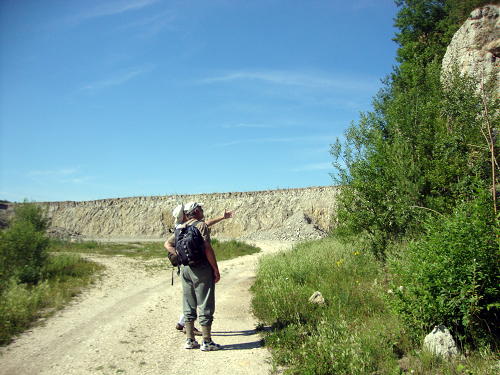
Thomas Kurtz is pointing out another interesting outcrop to me.
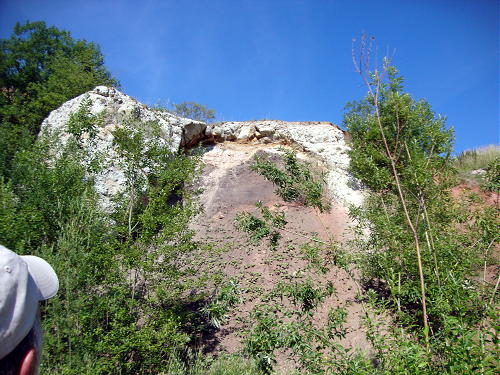
This is another outcrop (much like the previous outcrop) clearly showing the thermal contact zone between the Bunte Breccia and the overlying, flädle-bearing suevite. .
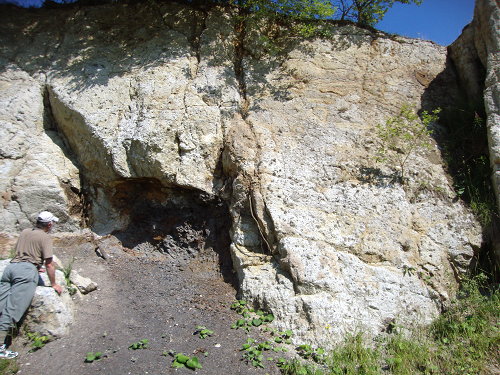
I got closer to see the contact zone between the Bunte Breccia and the overlying Ries Crater suevite.
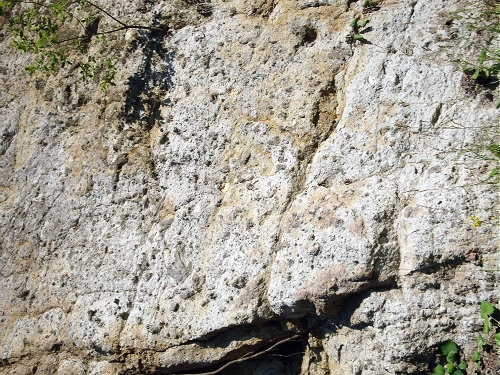
The slightly more resistant flädle stand-out in relief on the weathered face of this outcrop of suevite.
(You can click on the above image in order to ENLARGE.)
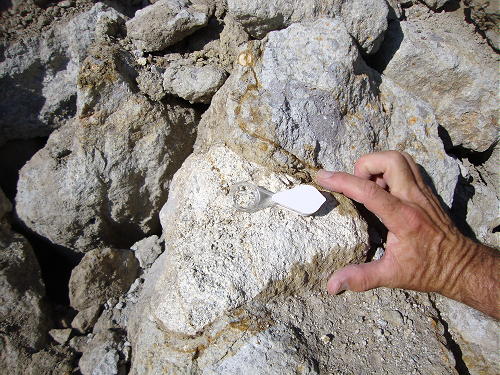
An image of a large, light-colored igneous clast from within the suevite formation is somewhat thermally altered.
(You can click on the above image in order to ENLARGE.)
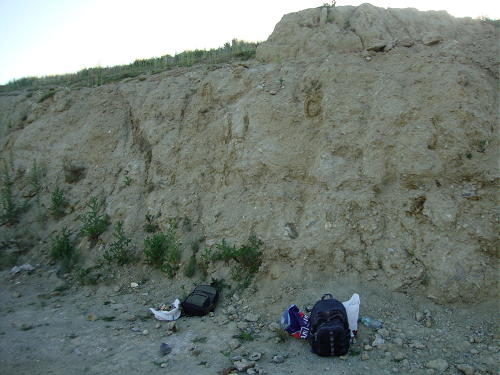
We found an outcrop where this portion of the suevite formation was less sintered (the groundmass had a higher percentage of clay and palagonite) and the individual clasts of relict flädle can be extracted intact (with a great deal of chiseling).
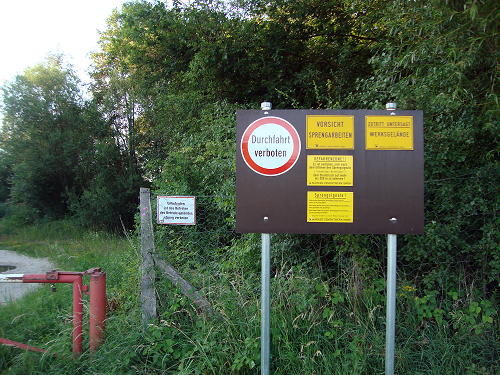
The sun was starting to set, so we started back to the vehicle. we took a different path back and at that trail head we encountered these warning signs! Apparently, the quarry shouldn't be accessed during operational hours (for obvious reasons).
(You can click on the above image in order to ENLARGE.)
At this time of year (and latitude) dusk is a lot longer period of time from what Moni and I are used to in San Diego. It was getting late and we still hadn't had our evening meal.
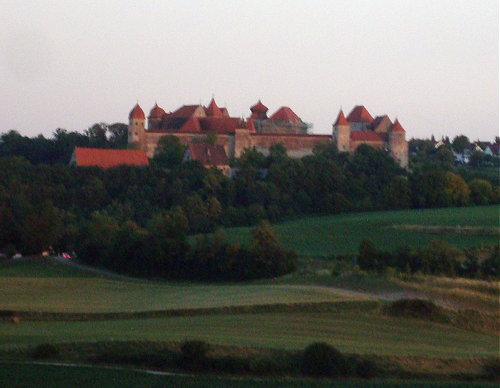
Thomas suggested we go to a restaurant that is inside a nearby castle (Harburg) along the Donau River.
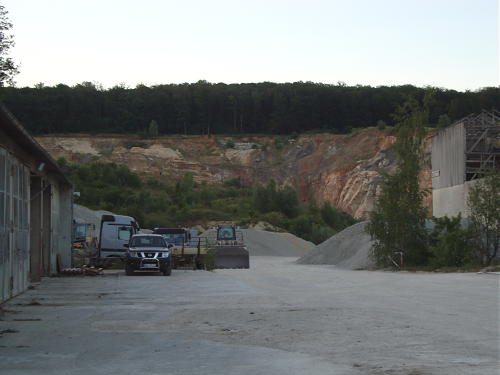
On the way to the Harburg castle we spotted this other quarry that has apparently been dug right into the outer rim of the crater. I suggested that this would be a great spot to visit on a future visit. I would really like to return to this area, but it will have to wait for future return trip to Germany.
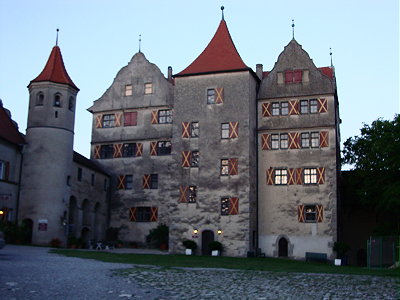
As we sat on the patio of the restaurant in the castle, this is the view that we had of the center courtyard, as dusk slowly turned to nightfall.
Time had gone by too quickly this day, but there were many memories captured that will be cherished for a long time.
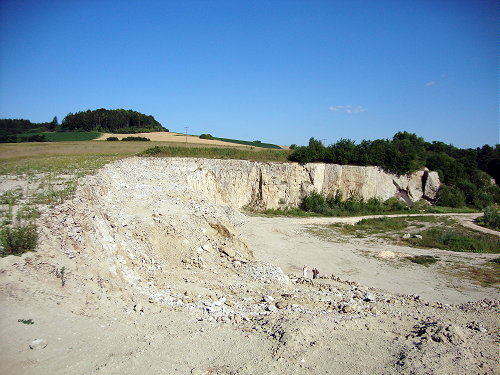
A good view of the entire quarry at Aumühle, also known as Geotop #9 out of many dozens of Geotop sites in Germany.
I hope that Thomas returns in time to recover the other Flädle before they are destroyed by the bulldozer.
(You can click on the above image in order to ENLARGE.)
I am looking forward to the next time that we can return to Nördlingen and again hike the Ries Crater.
The Wikipedia entry for: Nordlingen Ries Crater
- contains links to the Nordlingen Ries Crater Meteorite.
http://en.wikipedia.org/wiki/Nordlingen Ries Crater
The PASSC Earth Impact Database website for: Ries Crater
- contains links to paper>s on the Nordlingen Ries Crater.
http://www.passc.net/EarthImpactDatabase/ries.html
41st Lunar and Planetary Science Conference (2010)
(U-Th)/He DATING OF THE NÖRDLINGER RIES IMPACT STRUCTURE, GERMANY - F. J. Cooper1,
- Conclusions: New (U-Th)/He zircon data for the Nördlinger Ries impact structure give a mean age of
13.60 ± 0.58 Ma (2??).
http://www.lpi.usra.edu/meetings/lpsc2010/pdf/2243.pdf
LINKS:
LANDESSCHAU UNTERWEGS - SENDUNGEN (2015)
(This video is in German) - "Mit einem Schlag - Die Meteoritenkrater Ries und Steinheim" - ARD Mediathek,
- Conclusions: New data suggest what was the composition of the "dual asteroid" that formed both the Steinheim and the Nördlinger Ries impact structures.
(05.09.2015 | 28:54 Min. | Verfügbar bis 06.03.2016 | Quelle: SWR)
http://www.ardmediathek.de/tv/Landesschau-unterwegs/
Geopark Ries -
http://www.geopark-ries.de/index.php/en/geopark_ries
http://www.geopark-ries.de/index.php/en
Flädle - impact glass - images:
http://kauscience.k12.hi.us/%7Eted/Craters/impactites/Fladen-111g-1.jpg
http://kauscience.k12.hi.us/%7Eted/Craters/impactites/Fladen-111g-2.jpg
More images of Flädle:
http://www.spacerocksuk.com/RiesFladle.jpg
http://de.wikipedia.org/w/index.php?title=Datei:Fl%C3%A4dle.jpg&filetimestamp=20051118213056
Webpages about impactites:
http://en.wikipedia.org/wiki/Impactite:
- "Impactites"
http://www.impact-structures.com/impactrocks.html:
- "Ernston Claudin Impact Structures"
http://projects.naturkundemuseum-berlin.de/rapa/discovery/index.html:
- "The Three Anniversaries of the Ries Crater"
http://www.swisseduc.ch/stromboli/impacts/noerdlinger-ries/gesteine-en.html:
- Rocks generated or altered by the asteroid impact
http://www.mindat.org/loc-68071.html:
- Chaoite (native carbon) from Möttingen, Ries Crater, Nördlingen, Swabia, Bavaria, Germany
Geopark definition:
http://www.geopark-ries.de/index.php/en/the_origin_of_the_noerdlinger_ries
Suevite definition:
http://en.wikipedia.org/wiki/Suevite
http://de.wikipedia.org/wiki/Suevit
The Suevite Webpage:
http://www.impact-structures.com/suevite/the_suevite_page.htm
Geotope definition:
http://en.wikipedia.org/wiki/Geotope
http://de.wikipedia.org/wiki/Geotop
http://www.lfu.bayern.de/geologie/geotope_schoensten/index.htm:
- this is the list+map of the 100 Geotope in Bavaria (auf Deutsch).
http://web.archive.org/web/20071226230225/http://www.geoakademie.de/AGH1_of-Dateien/Geotope/ListeNatGeotope.htm:
- this is the list of the 77 NATIONAL Geotope in Germany (auf Deutsch).
Geopark Info Brochure for Bavaria :
http://www.geopark-ries.de/index.php/en/content/download/315/1541/file/GP_Information_Booklet.pdf
Bringemeier, D.
Suevite Superposition on the Bunte Breccia in Nordlinger Ries/Germany:
- contains links to papers on the Nordlingen Ries Crater.
http://www.lpi.usra.edu/meetings/programs/sudburywa.txt
Bringemeier D.*
Suevite Superposition on the Bunte Breccia in Nordlinger Ries/Germany -
New Findings on the Transport Mechanism of Impactites
Research undertaken in the last decades in Nordlinger Ries,
Germany, has emphasized repeatedly the sharp contact between
Bunte breccia and suevite. However, extensive investigations into
this layer boundary have not yet been possible due to
insufficient outcrop ratios.
New outcrops enabled an in-depth investigation into the
superposition of suevite on the Bunte breccia, which is assigned
a key role in interpreting the transport mechanisms of ejecta of
large impact.
In two quarries (Otting, Aufhausen/Seelbronn), lying several
kilometres east and south-southwest of the crater, the contact
between the suevite and Bunte breccia was recorded in detailed
sections on outcrops of over 50 m in length.
It was possible to confirm studies made in the 1960s by WAGNER
(1) that suggested a division of the suevite into main suevite,
rich in pancake bombs (also called "fladle," and a relatively
well-sorted, thin-base suevite consisting of fine gravel. A
semiquantitative analysis of the just slightly consolidated base
suevite revealed the main constituent to be "fresh," bubble-
abundant, albeit sometimes bubble-deficient, angular glasses.
Secondary, crystalline and sedimentary rock clasts and very
rarely "fladle" were detected. Of significance for the transport
mechanism of the base suevite is its content of Bunte breccia
fragments and the discovery of shell fragments. Between the base
suevite and the Bunte breccia is a crystalline breccia of ca. 0.1
m in thickness which is separated from the Bunte breccia by a
sharp boundary. In some areas a transition bed is visible between
the crystalline breccia and the base suevite. This transition bed
indicates an erosive reworking of crystalline breccia by the base
suevite. In one of the sections (Aufhausen/Seelbronn) the base
suevite was not observed as here the main suevite lay either on
the crystalline breccia or directly on the Bunte breccia. The
crystalline breccia is highly altered and in the transition to
main suevite contains disintegrated glasses.
In both sections structures were established that can be
explained only by an erosive reworking of the subsoil caused by a
shifting viscous suevite flow. Particulary on the flanks of the
hummocks of Bunte breccia, lying several metres higher, the
layers below the main suevite have been plained, compressed, and
mixed by the suevite flow. In the Aufhausen/Seelbronn section
hookshaped, decimetre-sized, finger-like compressions of Bunte
breccia and crystalline breccia project into the main suevite. A
clear erosive discordance between the main suevite and the base
suevite is visible in the Otting section.
(1) Wagner G. H. (1965) Jh. geol. Landesamt Baden-Wurttemberg,
vol. 7, p. 199-222.
For for more information, please contact me by email:
Bolide*chasseur
